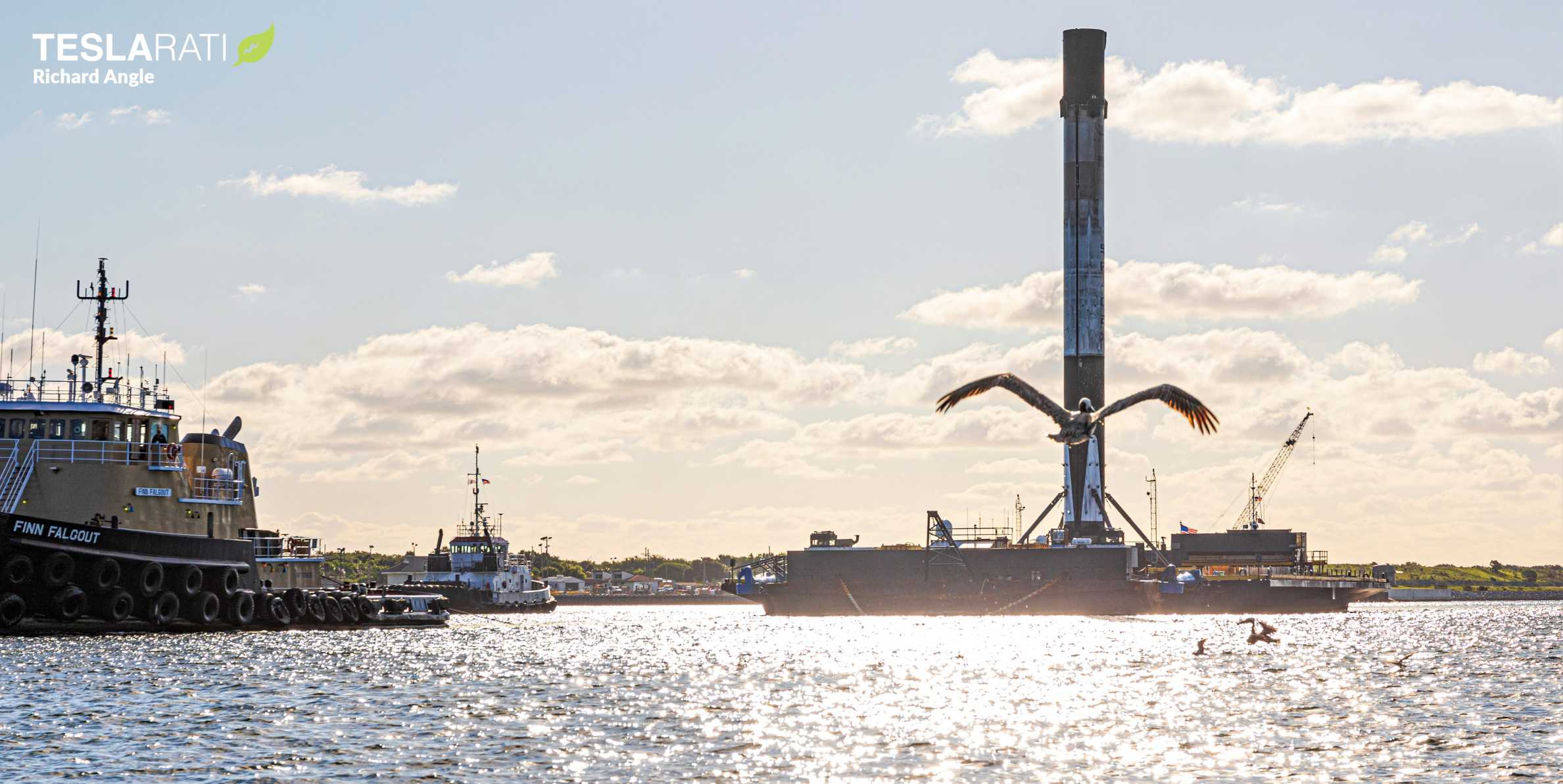
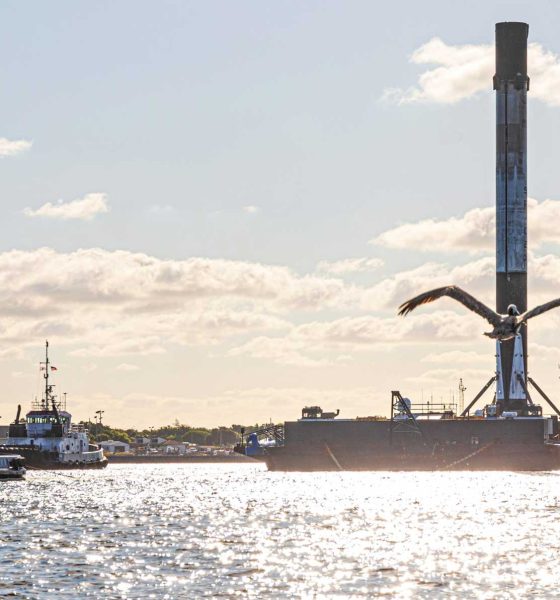
News
SpaceX’s rocket reusability dream is within reach after fastest recovery yet
SpaceX and CEO Elon Musk’s rocket reusability dream appears to be within reach for the first time ever after technicians managed to retract the most recently-launched Falcon 9 booster’s landing legs and bring it horizontal in record time.
On the heels of a SpaceX’s second orbital-class Falcon 9 launch, landing, and recovery just this month, the recovery milestone could mean that booster B1059 is being prepared for the fastest turnaround in the company’s history. Together, with two Starlink launches now complete less than two weeks into June 2020 and a third internet satellite mission scheduled as early as June 22nd, the odds are better than ever that SpaceX will be able to pull off a record launch cadence heading into the second half of the year.
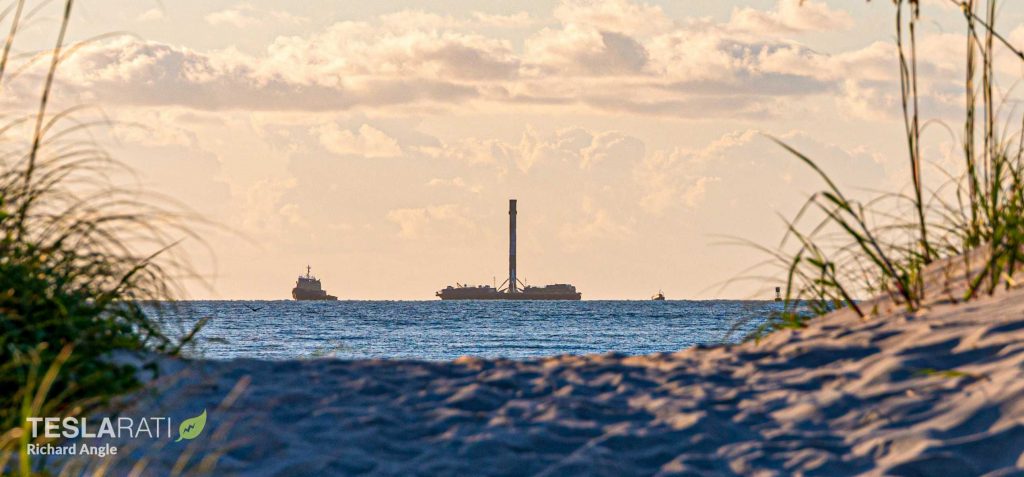
Averaged out, a sustained frequency of one launch every ~7 days would give SpaceX the ability to perform more than 50 orbital launches annually. In fact, just earlier this year, an environmental impact assessment completed for upgrades at Kennedy Space Center (KSC) Pad 39A revealed plans for as many as 70 annual launches from SpaceX’s two Florida pads by 2023.
Technically, SpaceX has already demonstrated that those two Florida launch pads – KSC Pad 39A and Cape Canaveral Air Force Station (CCAFS) LC-40 – are able to support 60-70 annual launches when pushed to their limits, with the latter pad recently performing two launches in just nine days for a potential maximum of 40 launches in one year. If SpaceX can pull off four Falcon 9 launches in 27 days, as it’s currently scheduled to do, the company will have already come a majority (75%) of the way to demonstrating that its fleet of Falcon rockets is also up to the task.
Currently the newest flown booster in SpaceX’s Falcon 9 fleet, the company has also wasted no time processing B1059 after ~8 am EDT return to Port Canaveral, kicking off landing leg retraction scarcely eight hours after berthing. B1059’s first sea recovery was also the second use of drone ship Of Course I Still Love You’s (OCISLY) upgraded Octagrabber, a tank-like robot used to keep technicians safe while remotely securing Falcon boosters on the high seas.
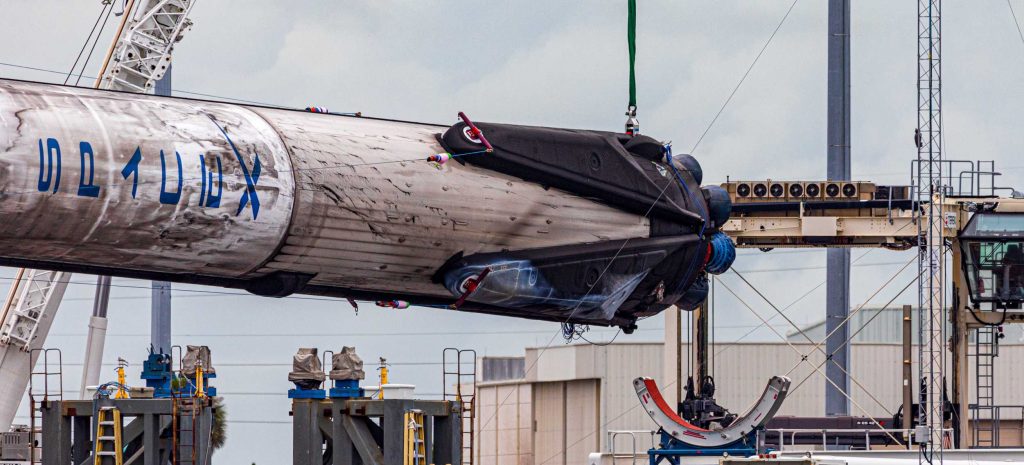
Octagrabber 2.0
By all appearances, SpaceX is using a new recovery method debuted with Falcon 9 booster B1058 earlier this month for the second time. With that significant operational tweak, the company no longer has to crane Falcon 9 boosters off of the drone ship before it can begin landing leg retraction – itself a process that’s barely a year old. By entirely supporting a booster with an upgraded Octagrabber robot and retracting its legs in situ, SpaceX can completely skip a recovery processing step, only lifting the rocket once it’s ready to be broken over (brought horizontal) and loaded onto a transporter.
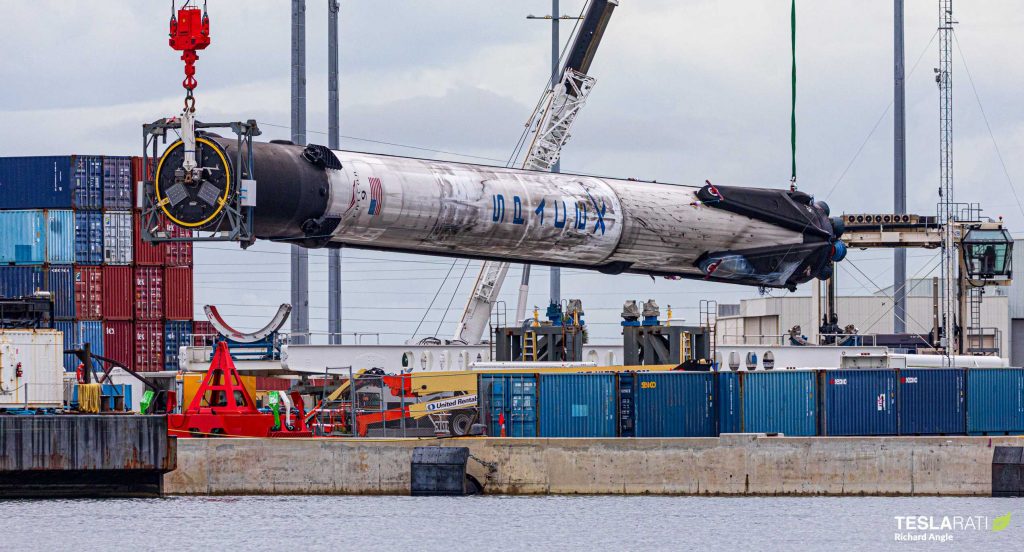
Unsurprisingly, on its first use, the improved efficiency allowed SpaceX to process a booster faster than any before it, breaking the previous record of ~1.9 days from port arrival to departure on a horizontal transporter. Now, B1059 is already on pace to beat B1058’s weeks-old recovery turnaround record. Extra-efficient recovery processing and the unprecedentedly rapid booster reuse it could soon enable will be crucial if SpaceX hopes to sustain a cadence of 3-6 Falcon 9 launches per month over the next few years.
Such a cadence is a necessity for the expedient deployment of the 12,000 to 40,000-satellite Starlink internet constellation. With SpaceX all but guaranteed to demonstrate three Starlink launches in a single month (in fact, less than three weeks), the company is making rapid progress in the right direction.

Speeding through recovery
In fact, as of writing, Falcon 9 B1059 has already had all four landing legs retracted and was lifted off drone ship OCISLY, broken over, and placed on SpaceX’s custom booster transporter less than 10 hours after it arrived in port. A step further, SpaceX took an incredible 8-9 hours after docking to bring the booster horizontal, crushing the previous record – ~27 hours – by a factor of three or more.
Given that unprecedented expediency, it wouldn’t be crazy to imagine that SpaceX could be aiming for a record-breaking booster turnaround on one of its next few Starlink launches, scheduled June 22nd and sometime in July. Held by the late booster B1056, SpaceX’s current turnaround record (the time between two launches) is 62 days, while the company and CEO Elon Musk’s ultimate reusability goal is to fly the same booster twice in just 24 hours.
Drone ship recoveries, of course, will almost always require at least a few extra days to travel back to port. Still, the fact that 99% of the processing needed to transport a booster can now be finished in as few as ~8 hours is the first unequivocal proof that a 24-hour turnaround is within SpaceX’s reach – so long as the rocket lands on land or the time in transit is excluded.
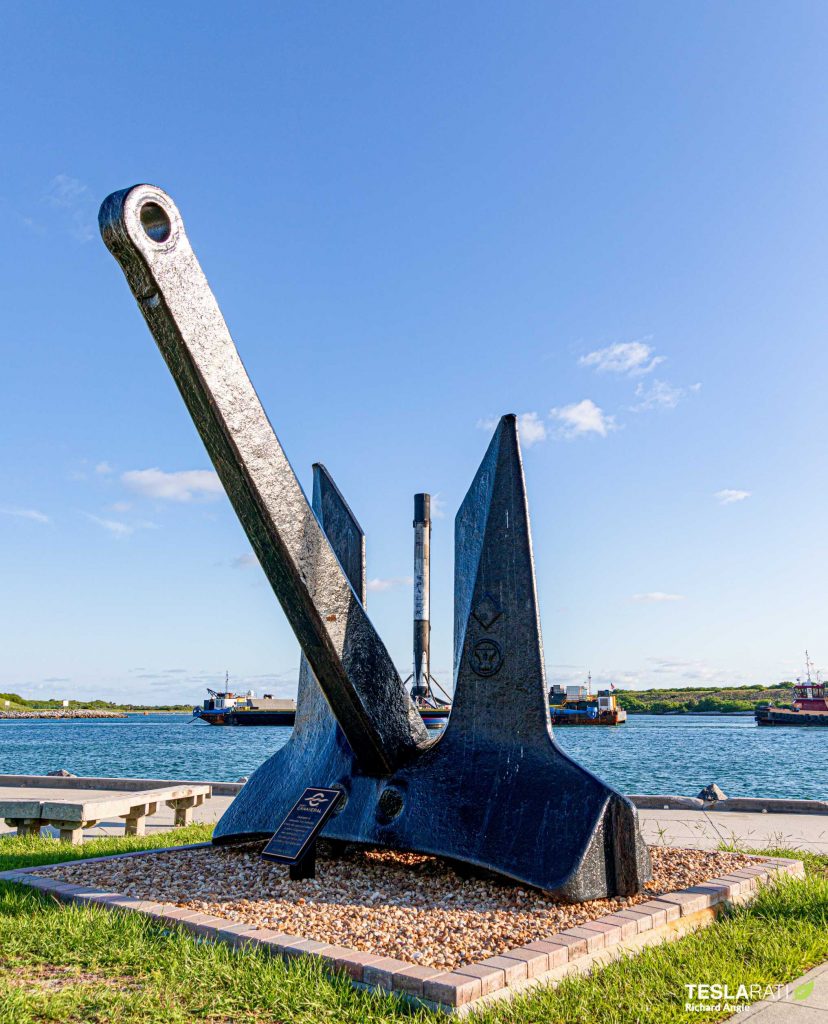
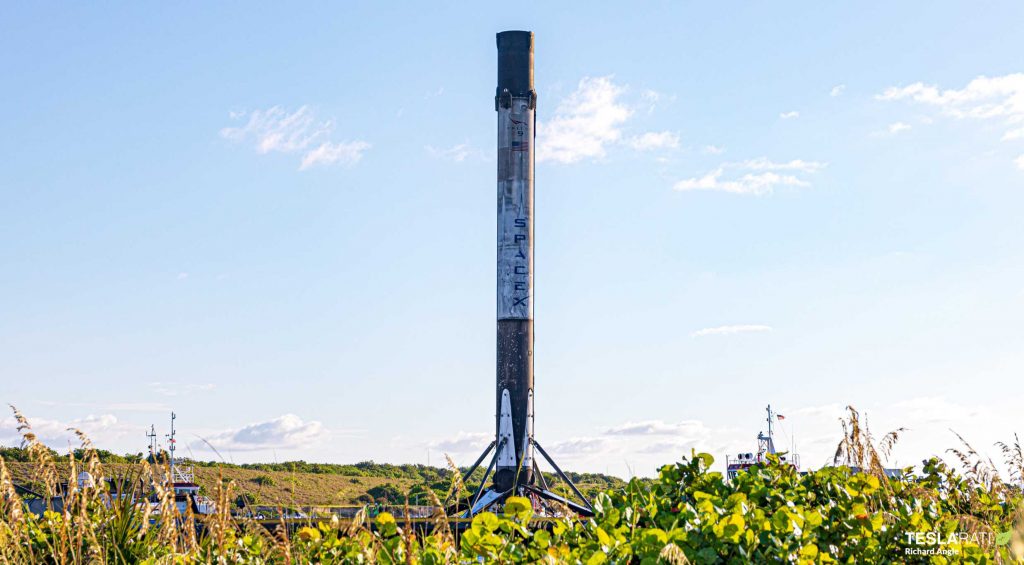
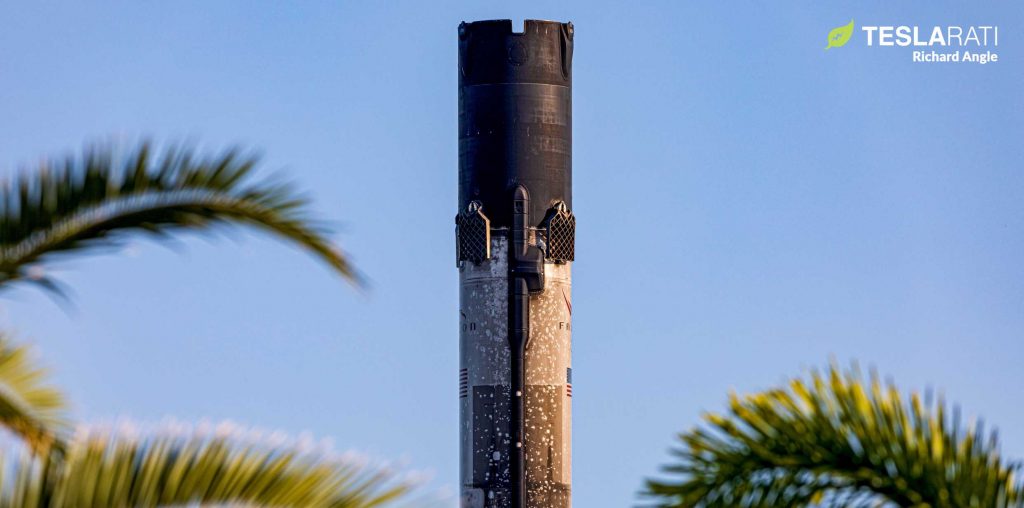


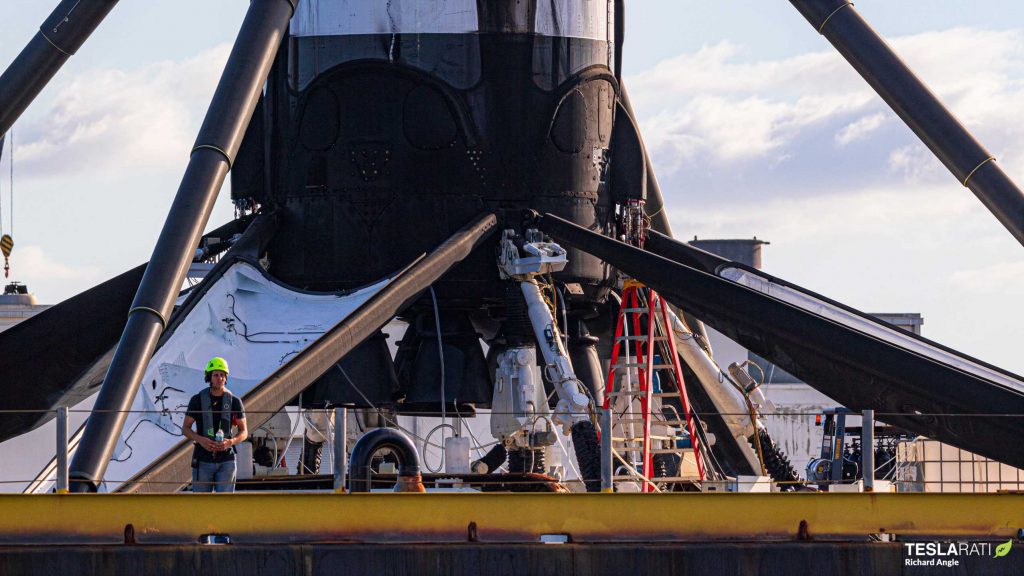
Check out Teslarati’s Marketplace! We offer Tesla accessories, including for the Tesla Cybertruck and Tesla Model 3.

Elon Musk
Elon Musk’s X will start using a Tesla-like software update strategy
The initiative seems designed to accelerate updates to the social media platform, while maintaining maximum transparency.

Elon Musk’s social media platform X will adopt a Tesla-esque approach to software updates for its algorithm.
The initiative seems designed to accelerate updates to the social media platform, while maintaining maximum transparency.
X’s updates to its updates
As per Musk in a post on X, the social media company will be making a new algorithm to determine what organic and advertising posts are recommended to users. These updates would then be repeated every four weeks.
“We will make the new 𝕏 algorithm, including all code used to determine what organic and advertising posts are recommended to users, open source in 7 days. This will be repeated every 4 weeks, with comprehensive developer notes, to help you understand what changed,” Musk wrote in his post.
The initiative somewhat mirrors Tesla’s over-the-air update model, where vehicle software is regularly refined and pushed to users with detailed release notes. This should allow users to better understand the details of X’s every update and foster a healthy feedback loop for the social media platform.
xAI and X
X, formerly Twitter, has been acquired by Elon Musk’s artificial intelligence startup, xAI last year. Since then, xAI has seen a rapid rise in valuation. Following the company’s the company’s upsized $20 billion Series E funding round, estimates now suggest that xAI is worth tens about $230 to $235 billion. That’s several times larger than Tesla when Elon Musk received his controversial 2018 CEO Performance Award.
As per xAI, the Series E funding round attracted a diverse group of investors, including Valor Equity Partners, Stepstone Group, Fidelity Management & Research Company, Qatar Investment Authority, MGX, and Baron Capital Group, among others. Strategic partners NVIDIA and Cisco Investments also continued support for building the world’s largest GPU clusters.
News
Tesla FSD Supervised wins MotorTrend’s Best Driver Assistance Award
The decision marks a notable reversal for the publication from prior years, with judges citing major real-world improvements that pushed Tesla’s latest FSD software ahead of every competing ADAS system.

Tesla’s Full Self-Driving (Supervised) system has been named the best driver-assistance technology on the market, earning top honors at the 2026 MotorTrend Best Tech Awards.
The decision marks a notable reversal for the publication from prior years, with judges citing major real-world improvements that pushed Tesla’s latest FSD software ahead of every competing ADAS system. And it wasn’t even close.
MotorTrend reverses course
MotorTrend awarded Tesla FSD (Supervised) its 2026 Best Tech Driver Assistance title after extensive testing of the latest v14 software. The publication acknowledged that it had previously criticized earlier versions of FSD for erratic behavior and near-miss incidents, ultimately favoring rivals such as GM’s Super Cruise in earlier evaluations.
According to MotorTrend, the newest iteration of FSD resolved many of those shortcomings. Testers said v14 showed far smoother behavior in complex urban scenarios, including unprotected left turns, traffic circles, emergency vehicles, and dense city streets. While the system still requires constant driver supervision, judges concluded that no other advanced driver-assistance system currently matches its breadth of capability.
Unlike rival systems that rely on combinations of cameras, radar, lidar, and mapped highways, Tesla’s FSD operates using a camera-only approach and is capable of driving on city streets, rural roads, and freeways. MotorTrend stated that pure utility, the ability to handle nearly all road types, ultimately separated FSD from competitors like Ford BlueCruise, GM Super Cruise, and BMW’s Highway Assistant.
High cost and high capability
MotorTrend also addressed FSD’s pricing, which remains significantly higher than rival systems. Tesla currently charges $8,000 for a one-time purchase or $99 per month for a subscription, compared with far lower upfront and subscription costs from other automakers. The publication noted that the premium is justified given FSD’s unmatched scope and continuous software evolution.
Safety remained a central focus of the evaluation. While testers reported collision-free operation over thousands of miles, they noted ongoing concerns around FSD’s configurable driving modes, including options that allow aggressive driving and speeds beyond posted limits. MotorTrend emphasized that, like all Level 2 systems, FSD still depends on a fully attentive human driver at all times.
Despite those caveats, the publication concluded that Tesla’s rapid software progress fundamentally reshaped the competitive landscape. For drivers seeking the most capable hands-on driver-assistance system available today, MotorTrend concluded Tesla FSD (Supervised) now stands alone at the top.
News
Elon Musk’s Grokipedia surges to 5.6M articles, almost 79% of English Wikipedia
The explosive growth marks a major milestone for the AI-powered online encyclopedia, which was launched by Elon Musk’s xAI just months ago.

Elon Musk’s Grokipedia has grown to an impressive 5,615,201 articles as of today, closing in on 79% of the English Wikipedia’s current total of 7,119,376 articles.
The explosive growth marks a major milestone for the AI-powered online encyclopedia, which was launched by Elon Musk’s xAI just months ago. Needless to say, it would only be a matter of time before Grokipedia exceeds English Wikipedia in sheer volume.
Grokipedia’s rapid growth
xAI’s vision for Grokipedia emphasizes neutrality, while Grok’s reasoning capabilities allow for fast drafting and fact-checking. When Elon Musk announced the initiative in late September 2025, he noted that Grokipedia would be an improvement to Wikipedia because it would be designed to avoid bias.
At the time, Musk noted that Grokipedia “is a necessary step towards the xAI goal of understanding the Universe.”
Grokipedia was launched in late October, and while xAI was careful to list it only as Version 0.1 at the time, the online encyclopedia immediately earned praise. Wikipedia co-founder Larry Sanger highlighted the project’s innovative approach, noting how it leverages AI to fill knowledge gaps and enable rapid updates. Netizens also observed how Grokipedia tends to present articles in a more objective manner compared to Wikipedia, which is edited by humans.
Elon Musk’s ambitious plans
With 5,615,201 total articles, Grokipedia has now grown to almost 79% of English Wikipedia’s article base. This is incredibly quick, though Grokipedia remains text-only for now. xAI, for its part, has now updated the online encyclopedia’s iteration to v0.2.
Elon Musk has shared bold ideas for Grokipedia, including sending a record of the entire knowledge base to space as part of xAI’s mission to preserve and expand human understanding. At some point, Musk stated that Grokipedia will be renamed to Encyclopedia Galactica, and it will be sent to the cosmos.
“When Grokipedia is good enough (long way to go), we will change the name to Encyclopedia Galactica. It will be an open source distillation of all knowledge, including audio, images and video. Join xAI to help build the sci-fi version of the Library of Alexandria!” Musk wrote, adding in a later post that “Copies will be etched in stone and sent to the Moon, Mars and beyond. This time, it will not be lost.”








